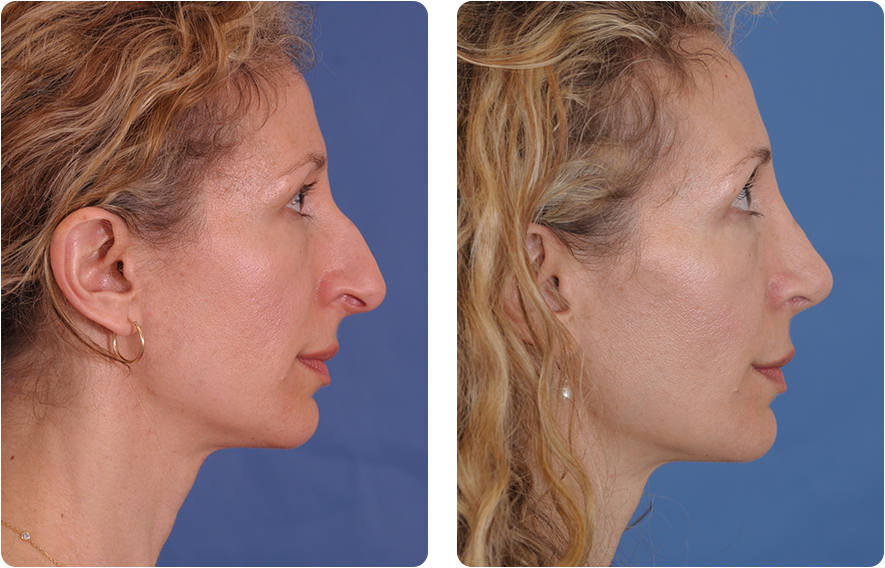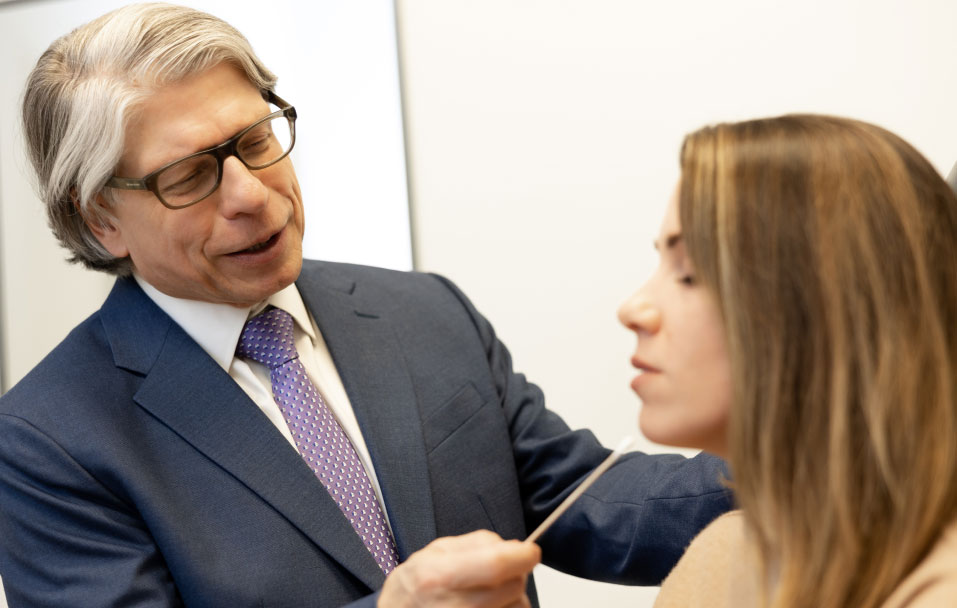

The operation consists of restoring, rearranging, or removing any bone or cartilage to give the nose a more pleasing appearance while improving and preserving nasal function. The goal of aesthetic rhinoplasty is to restore or create symmetry, balance, and proportion to one’s appearance.


Revision rhinoplasty is corrective surgery for those who have experienced complications or unsatisfactory results from previous nose surgery. Dr. Fedok has performed revision rhinoplasty for decades and has special expertise in the management of complex cases.


Candidates include individuals who desire a nose that appears in harmony with the rest of their face. The reason a patient may seek rhinoplasty may be to correct a cosmetic problem or may be seeking a reconstructive solution after an injury. Rhinoplasty is a procedure that spans all ages. In fact, correction of a long drooping nose may also be part of a plan for facial rejuvenation. The best candidates are those with realistic expectations and are willing to work with Dr. Fedok to define achievable goals.

Before surgery, Dr. Fedok takes photographs of the patient’s face and plans how to proceed in each case. Part of this planning may include computer imaging, so patients can see an approximation of how the improvements may look. Because of the inherent limitations of surgery, it is often difficult to duplicate the exact idea as it was presented. No ethical physician can “guarantee” the results of any treatment. The surgical procedure can take one-and-one-half hours to four hours or more, depending on the extent of work that needs to be done. Depending on the goals of the surgery, Dr. Fedok will plan to perform the rhinoplasty procedure via either an open (where a small incision is placed on the nasal columella) or an endonasal approach (where no external incisions are placed). In some cases, Dr. Fedok will perform the surgery with a dorsal preservation goal, while in others he will perform the surgery in a structural manner. In order to optimize the “structure” of the nose, grafts may be used. Dr. Fedok RARELY uses implants in the nose. He will routinely use cartilage grafts harvested from the patient’s ears, nasal septum , and when necessary even from one of the patient’s ribs. In general, Dr. Fedok finds that packing the nose is usually not necessary. This contributes significantly to the reduction in swelling and discoloration patients experience in the postoperative period.
After the surgery, Dr. Fedok places a tan, taped splint on your nose. He also places internal nasal splints. These will remain in place for at least a week. Dr. Fedok advises you to remain out of bed, and in an upright position, as much as possible. It is also advisable to sleep with the head of the bed elevated. The elevated position helps reduce swelling and promotes healing. Ice-cold washcloth compresses should be used throughout the day and night immediately following your surgery to reduce swelling, slow oozing, and minimize bruising.
Feel free to browse the Rhinoplasty Before and After photos on the Fedok Plastic Surgery website to see examples of previous surgical cases. Additional photos are available in the office.
VIEW THE GALLERY

If external sutures are used, Dr. Fedok will remove them approximately seven days after the surgery. One week following the procedure, the splint dressing is typically taken off. In most cases, no further dressing is necessary. At this point, patients can typically resume work, school, and social activities. Patients are advised not to overexert, lift heavy objects, or blow their noses for at least two to three weeks. Additionally, during the next six weeks, patients must exercise caution to avoid injuring the nose. After removing the nasal splint, it is important for patients who wear glasses not to rest them on the top of the nose for six weeks. Instead, the glasses should be suspended from the forehead using tape or supported on top of the original nasal splint. These minor inconveniences are well worth the effort required to achieve a satisfactory postoperative result and a pleasant-looking nose.
After the end of the first week following surgery, most patients will begin to experience reduced swelling and discoloration. The patient may feel the swelling more than they see it. This slight swelling will diminish gradually over the following weeks and resolve within a few months. However, some small amount of swelling persists in the skin for months. The “final” rhinoplasty result may not be obvious for up to one year or more after surgery. The swelling sensation will be more noticeable in the morning hours and subside during the day. Patients may experience intermittent nasal stuffiness, which will decrease over the first month or two following surgery. It is permissible to take oral antihistamines and decongestants to help reduce congestion as directed.


Although rhinoplasty is a generally safe procedure, as with any surgery, there are potential risks. One of the most common risks is bleeding. While it is common to experience some bleeding during and immediately following surgery, excessive bleeding can be a concern. Other risks include the risks of infection, scarring, healing problems, continuing nasal breathing difficulty, and persistent deformities of the nose.
Booking a consultation with Dr. Fedok is the right way to go if you are considering rhinoplasty. His extensive experience and training consistently deliver satisfactory before and after rhinoplasty results for patients throughout Foley, Daphne, Gulf Shores, and Fairhope. His procedures are tailored to meet each patient’s unique needs. Schedule your consultation today to learn more.

By Dr. Fedok, a well-respected and widely published double board-certified plastic surgeon whose before and after gallery, RealSelf and Google Reviews reflect his trusted expertise.

Patients who expect to see a perfectly-shaped nose immediately after the removal of the dressing may be disappointed. Swelling is common but will gradually diminish once the splint is removed. The splint may leave a slight impression, but this will usually fade within a few hours following its removal. By the end of the second week, the average observer may not notice any residual swelling. In the subsequent weeks, the nose will progressively assume its final shape. The remaining two or three percent of the swelling will gradually resolve over a year or more as the components of the nasal surgery align and enhance the definition of the new nose. It is important to note that the thickness of the skin can impact the duration it takes for the nose to reach its ultimate form, and each case is unique. Patients will have the opportunity to discuss skin limitations with Dr. Fedok during their preoperative consultation.
The incisions made inside the nose do not leave visible scars. To increase the visibility of the nasal structures, these incisions may be connected with a small incision under the tip of the nose crossing the central portion between the nostrils (the columella). This incision is designed to leave an inconspicuous scar after healing is completed. When it is necessary to narrow wide nostrils, incisions are made at the base of the nostril near or in the crease, and this area will be slightly red for a few weeks.
Patients should remember that there is a limit to the corrective procedures that can be completed. The surgical goal is to improve one’s looks and not to match the “ideal” image in a patient’s mind. Rhinoplasty surgery has limitations which include the contour and shape of the face; the texture and thickness of the skin; the inclination of the chin, lip, and forehead; the depth of the angle between the forehead and the nose; the height of the individual; and the healing powers of the person’s tissues. Often, it is necessary to correct a receding chin at the time of nose surgery to bring harmony to the facial features.
Patients should be aware that noses that have experienced significant trauma due to sports injuries, or accidents, or are naturally crooked can present challenges in achieving a perfectly straight nose. While most of the time these noses can be corrected with a single operation, there are instances where the tissue may retain a memory of the previous curvature, causing a slight deviation. In such cases, a second-stage surgery may be necessary to achieve the best possible result, typically performed approximately three months to one year later.
Rhinoplasty and revision rhinoplasty costs can vary widely depending on several factors, including the surgeon’s experience, geographic location, and the complexity of the procedure. It is best to book your consultation with Dr. Fedok to discuss the breakdown of rhinoplasty costs.
Healing times can vary from person to person. In general, patients can expect some initial swelling and bruising for the first 1-2 weeks. However, complete healing and final results may take several months to a year. Most patients can return to their normal activities within a few weeks.
It is essential to avoid putting any pressure on your nose, including wearing glasses, for six weeks after surgery. Your surgeon will provide specific guidelines, but typically, you may need to switch to contact lenses or use special tape to support your glasses on the forehead until your nose has healed sufficiently. A splint will also be provided for protection.
Your nose is delicate after surgery, and it is important to handle it gently. Avoid any accidental bumps or pressure and follow your surgeon’s post-operative care instructions carefully to ensure a smooth healing process. Protecting your nose from trauma during the initial healing phase is crucial.
Revision nose surgery is more complex and should only be considered after the initial rhinoplasty has fully healed and the final results have stabilized. This can take at least 6-12 months or longer. The timing for revision rhinoplasty varies depending on individual circumstances, so consult with your surgeon to determine the appropriate timeframe.
Open rhinoplasty involves a small external incision across the columella, offering a comprehensive view and precise control for complex cases. In contrast, closed rhinoplasty utilizes incisions within the nostrils, leaving no external scars, and is typically suitable for less complex procedures. The choice depends on your specific nasal concerns and your surgeon’s recommendation. Both techniques aim to enhance nasal aesthetics effectively.